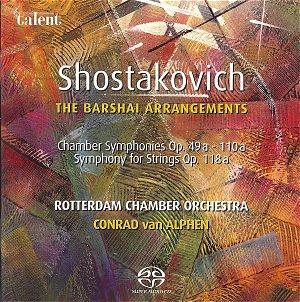 |
 |
|

Buy
through MusicWeb
for £13.50 postage paid World-wide.
Musicweb
Purchase button
|
Dmitri SHOSTAKOVICH
(1906-1975)
Symphony for Strings, Op. 118a (arr. Barshai, after String Quartet
No. 10, 1964) [26:08]
Chamber Symphony, Op. 49a (arr. Barshai, after String Quartet No.
1, 1938) [15:59]
Chamber Symphony, Op. 110a (arr. Barshai, after String Quartet No.
8, 1960) [21:56]
 Rotterdam Chamber Orchestra/Conrad van Alphen
Rotterdam Chamber Orchestra/Conrad van Alphen
rec. Studio 5, Miziekcentrum van de Omroep, Hilversum
 TALENT DOM 2929 72 [64:03]
TALENT DOM 2929 72 [64:03]
|
|
|
The performance of string chamber music with multiple players
per part has ample precedent, especially in larger-framed pieces
that require more players in the first place. Mendelssohn's
Octet and Wagner's Siegfried-Idyll are established repertoire
standards in "expanded" performance. Otto Klemperer
recorded one of the great Mozart serenades with such forces,
while the supposed purist Toscanini played and recorded Beethoven's
Septet for strings and winds with a larger ensemble of his NBC
Symphony strings.
The practice of doubling parts in string quartet music, however,
remains suspect in some quarters. The unstated goal of such
"expanded" performances is, presumably, to access
a wider range of expression than is available within the chamber
framework. The underlying premise - that "more" is,
ipso facto, "better" - doesn't necessarily
apply to music, but neither does it preclude getting a good
result. Certainly this appears to have been conductor Rudolf
Barshai's purpose in arranging a number of Shostakovich's knotty
string quartets as "chamber symphonies" and "string
symphonies". The present disc gathers three of those arrangements.
Barshai's transcriptions are most effective where the music
incorporates overtly "symphonic" musical gestures.
In the Allegretto furioso movement of the Symphony for
Strings, the violent lower-string chords and subsequent whirling
figurations above - the latter recalling the finale of the Fifth
Symphony - pack more punch in this larger-scaled realization.
So does the sudden outburst of tone and vigorous activity in
the Allegro molto of Opus 110a. The Allegro finale
of Op 49a begins playfully, but the imposing sound of massed
cellos and basses - the latter absent in the original quartet
- conjure an increasing sense of foreboding.
In some places, Barshai retains a solo string distribution.
Sometimes, it's simple discretion: some of those passages might
be difficult to negotiate successfully with a larger number
of players although the use of multiple players per part is
more forgiving in the octaves at the start of Opus 110a's fourth
movement. Other such passages gain in emotional power from the
contrast with the fuller sonorities elsewhere. The latter is
certainly true at the start of the Adagio of the Symphony
for Strings; paradoxically, as the remaining sectional players
join in, the expressive effect is neutralized! Similarly, the
solo strands at 1:20 of Opus 110a gradually expand into a full-throated
arrival at 3:40, at which point the edgy, sidling chromatics
slide into more nearly diatonic harmony - the tone thus clarifying
the structure.
Here and there, for those familiar with the originals, the orchestral
format brings losses as well as gains. In the second movement
of Opus 49a, the haunting sparseness of the widely spaced textures
- the sort of thing so easily realized in a quartet - is dissipated
in the resonance of the additional instruments. And, at 6:25
in the finale of the Symphony for Strings, with subsidiary parts
moving against the more sustained theme, definition is less
clear than in a good quartet performance, although everything
"sounds".
The questionable moments can't be blamed on the Rotterdam Chamber
Orchestra's committed performances. The players take the composer's
metric irregularities in stride, and shape broad phrases with
assurance, even in the slow movements. There are patches of
dry articulation here and there, but elsewhere the sonority
is warm and polished, particularly from the lower instruments.
The climax at 2:04 of the second Moderato in Op. 49a
elicits an impassioned outpouring of bass tone. The cellos dig
into the low legato phrases of the first movement with a dusky
depth. The unanimity of musical intent is a tribute to the players
as well as to conductor Conrad van Alphen.
I enjoyed the vivid, pleasantly ambient recorded sound, the
effect of which in the Allegretto of Opus 110a is strikingly
directional.
Stephen Francis Vasta
Stephen Francis Vasta is a New York-based conductor, coach, and journalist.
|
|

